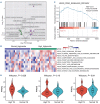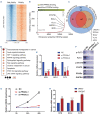Interplay between hypertriglyceridemia and acute promyelocytic leukemia mediated by the cooperation of peroxisome proliferator-activated receptor-α with the PML/RAR α fusion protein on super-enhancers
- PMID: 35546300
- PMCID: PMC9614538
- DOI: 10.3324/haematol.2021.280147
Interplay between hypertriglyceridemia and acute promyelocytic leukemia mediated by the cooperation of peroxisome proliferator-activated receptor-α with the PML/RAR α fusion protein on super-enhancers
Abstract
Patients with newly diagnosed acute promyelocytic leukemia (APL) are often obese or overweight, accompanied by metabolic disorders, such as dyslipidemia. However, the link between dyslipidemia and leukemia is obscure. Here, we conducted a retrospective study containing 1,412 cases (319 newly diagnosed APL patients, 393 newly diagnosed non-APL acute myeloid leukemia patients, and 700 non-tumor controls) and found that APL patients had higher triglyceride levels than non- APL and control groups. Using clinical data, we revealed that hypertriglyceridemia served as a risk factor for early death in APL patients, and there was a positive correlation between triglyceride levels and leukocyte counts. RNA sequencing analysis of APL patients having high or normal triglyceride levels highlighted the contribution of peroxisome proliferatoractivated receptor-α (PPARα), a crucial regulator of cell metabolism and a transcription factor involved in cancer development. The genome-wide chromatin occupancy of PPARα revealed that PPARα co-existed with PML/RARα within the super-enhancer regions to promote cell proliferation. PPARα knockdown affected the expression of target genes responsible for APL proliferation, including FLT3, and functionally inhibited the proliferation of APL cells. Moreover, in vivo results in mice having high fat diet-induced high triglyceride levels supported the connection between high triglyceride levels and the leukemic burden, as well as the involvement of PPARα-mediated-FLT3 activation in the proliferation of APL cells. Our findings shed light on the association between APL proliferation and high triglyceride levels and provide a genetic link to PPARα-mediated hyperlipidemia in APL.
Figures






Similar articles
-
Growth suppression of acute promyelocytic leukemia cells having increased expression of the non-rearranged alleles: RAR alpha or PML.Oncogene. 1995 Jun 15;10(12):2307-14. Oncogene. 1995. PMID: 7784078
-
PML/RARalpha and FLT3-ITD induce an APL-like disease in a mouse model.Proc Natl Acad Sci U S A. 2002 Jun 11;99(12):8283-8. doi: 10.1073/pnas.122233699. Proc Natl Acad Sci U S A. 2002. PMID: 12060771 Free PMC article.
-
Activation of G0S2 is coordinated by recruitment of PML/RARα and C/EBPε to its promoter during ATRA-induced APL differentiation.J Leukoc Biol. 2017 Mar;101(3):655-664. doi: 10.1189/jlb.1A0316-116R. Epub 2016 Sep 7. J Leukoc Biol. 2017. PMID: 27605212
-
The molecular biology of acute promyelocytic leukemia.Cancer Treat Res. 1999;99:75-124. doi: 10.1007/978-0-585-38571-6_4. Cancer Treat Res. 1999. PMID: 9891864 Review.
-
Characterisation of the PML/RAR alpha rearrangement associated with t(15;17) acute promyelocytic leukaemia.Curr Top Microbiol Immunol. 1997;220:81-112. doi: 10.1007/978-3-642-60479-9_6. Curr Top Microbiol Immunol. 1997. PMID: 9103677 Review.
Cited by
-
Cellular hierarchy insights reveal leukemic stem-like cells and early death risk in acute promyelocytic leukemia.Nat Commun. 2024 Feb 16;15(1):1423. doi: 10.1038/s41467-024-45737-7. Nat Commun. 2024. PMID: 38365836 Free PMC article.
-
Phase separation of PML/RARα and BRD4 coassembled microspeckles governs transcriptional dysregulation in acute promyelocytic leukemia.Proc Natl Acad Sci U S A. 2024 Aug 20;121(34):e2406519121. doi: 10.1073/pnas.2406519121. Epub 2024 Aug 13. Proc Natl Acad Sci U S A. 2024. PMID: 39136995 Free PMC article.
-
Plasma lipidomic profiling of thiopurine-induced leukopenia after NUDT15 genotype-guided dosing in Chinese IBD patients.Front Nutr. 2023 Jun 27;10:1138506. doi: 10.3389/fnut.2023.1138506. eCollection 2023. Front Nutr. 2023. PMID: 37441519 Free PMC article.
-
Obesity and Leukemia: Biological Mechanisms, Perspectives, and Challenges.Curr Obes Rep. 2024 Mar;13(1):1-34. doi: 10.1007/s13679-023-00542-z. Epub 2023 Dec 30. Curr Obes Rep. 2024. PMID: 38159164 Free PMC article. Review.
-
Dyslipidemia in diffuse large B-cell lymphoma based on the genetic subtypes: a single-center study of 259 Chinese patients.Front Oncol. 2023 Jun 9;13:1172623. doi: 10.3389/fonc.2023.1172623. eCollection 2023. Front Oncol. 2023. PMID: 37384286 Free PMC article.
References
-
- Estey E, Thall P, Kantarjian H, Pierce S, Kornblau S, Keating M. Association between increased body mass index and a diagnosis of acute promyelocytic leukemia in patients with acute myeloid leukemia. Leukemia. 1997;11(10):1661-1664. - PubMed
Publication types
MeSH terms
Substances
LinkOut - more resources
Full Text Sources
Medical
Molecular Biology Databases
Miscellaneous

